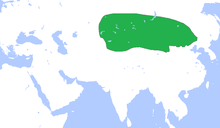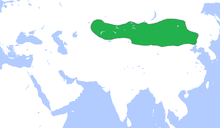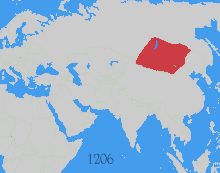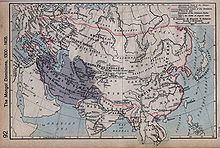
| Home | Sources Directory | News Releases | Calendar | Articles | | Contact | |
Nomadic empire
Nomadic Empires, sometimes also called Steppe Empires, Central or Inner Asian Empires, are the empires erected by the bow wielding, horse riding, Eurasian nomads, from Classical Antiquity (Scythia) to the Early Modern era (Dzungars).
Not all nomadic cultures were able to erect empires. Warrior peoples like the Cimmerians, Avars, Magyars, Pechenegs and Kipchaks have conquered vast areas and founded kingdoms but did not subjugate other nations in order to be considered as empires. The Comanches and other Native American horse cultures ruled large areas, but never produced any sort of state apparatus.
Contents |
[edit] Xiongnu Empire
The Xiongnu were a confederation of nomadic tribes from Central Asia with a ruling class of unknown origin and other subjugated tribes. They lived on the steppes north of China between the 3rd century and the 460s, their territories including modern day Mongolia, southern Siberia, western Manchuria, and the modern Chinese provinces of Inner Mongolia, Gansu, and Xinjiang. Relations between early Chinese dynasties and the Xiongnu were complicated and included military conflict, exchanges of tribute and trade, and marriage treaties. They were considered so dangerous and disruptive that the Qin Dynasty ordered the construction of the Great Wall to protect China from Xiongnu attacks.They are Turk and Mongol.
[edit] Hunnic Empire
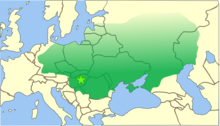
The Huns were a confederation of Eurasian tribes from the Steppes of Central Asia. Appearing from beyond the Volga River some years after the middle of the 4th century, they conquered all of eastern Europe, ending up at the border of the Roman Empire in the south, and advancing far into modern day Germany in the north. Their appearance in Europe brought with it great ethnic and political upheaval and may have stimulated the Great Migration. The empire reached its largest size under Attila between 447 and 453.
[edit] Rouran Empire
The Rouran, Juan Juan, or Ruru were a confederation of nomadic tribes on the northern borders of China from the late 4th century until the late 6th century. They controlled the area of Mongolia from the Manchurian border to Turpan and, perhaps, the east coast of Lake Balkhash, and from the Orkhon River to the China Proper.
[edit] Göktürks

The Göktürks or Kök-Türks were a Turkic people of ancient North and Central Asia and northwestern China. Under the leadership of Bumin Khan and his sons they established the first known Turkic state around 546, taking the place of the earlier Xiongnu as the main power in the region. They were the first Turkic tribe to use the name "Türk" as a political name. The empire was split into a western and an eastern part around 600, merged again 680, and finally declined after 734.
[edit] Uyghur Empire
The Uyghur Empire was a Turkic empire that existed in present day Mongolia and surrounding areas for about a century between the mid 8th and 9th centuries. It was a tribal confederation under the Orkhon Uyghur nobility. It was established by Özmish Khan in 744, taking advantage of the power vacuum in the region after the fall of the Gökturk Empire. It collapsed after a Kyrgyz invasion in 840.
[edit] Mongol Empire
The Mongol Empire was the largest contiguous land empire in history at its peak, with an estimated population of over 100 million people. The Mongol Empire was founded by Genghis Khan in 1206, and at its height, it encompassed the majority of the territories from southeast Asia to eastern Europe.
After unifying the Mongol'Turkic tribes, the Empire expanded through conquests throughout continental Eurasia. During its existence, the Pax Mongolica facilitated cultural exchange and trade on the Silk Route between the East, West, and the Middle East in the period of the 13th and 14th centuries.
After the death of Möngke Khan in 1259, the empire split into four parts (Yuan Dynasty, Il-Khans, Chagatai Khanate and Golden Horde), each of which was ruled by its own Khan, though the Yuan rulers had nominal title of Khagan. After the disintegration of the western khanates and the fall of the Yuan Dynasty in China in 1368, the empire finally broke up.
[edit] Timurid Empire
The Timurids, self-designated Gurkä�nä«, were a Turko-Mongol dynasty, established by the warlord Timur in 1370 and lasting until 1506. At its zenith, the Timurid Empire included the whole of Central Asia, Iran and modern Afghanistan, as well as large parts of Mesopotamia and the Caucasus.
[edit] Dzungars
The Dzungars were a confederation of several Oirat (or West Mongolian) tribes who formed and maintained the last horse archer empire from the early 17th century to the middle 18th century. They emerged in the early 17th century to fight the Altan Khan of the Khalkha, the Jasaghtu Khan and their Manchu patrons for dominion and control over the Mongolian people and territories. In 1756 this last nomadic power was dissolved due to the Oirat princes' succession struggle and costly war with the Qing Dynasty.
[edit] Further reading
- Amitai, Reuven; Biran, Michal (editors). Mongols, Turks, and others: Eurasian nomads and the sedentary world (Brill's Inner Asian Library, 11). Leiden: Brill, 2005 (ISBN 90-04-14096-4).
- Drews, Robert. Early riders: The beginnings of mounted warfare in Asia and Europe. N.Y.: Routledge, 2004 (ISBN 0-415-32624-9).
- Grousset, Rene. The Empire of the Steppes: a History of Central Asia, Naomi Walford, (tr.), New Brunswick, NJ: Rutgers University Press, 1970.
- Hildinger, Erik. Warriors of the steppe: A military history of Central Asia, 500 B.C. to A.D. 1700. New York: Sarpedon Publishers, 1997 (hardcover, ISBN 1-885119-43-7); Cambridge, MA: Da Capo Press, 2001 (paperback, ISBN 0-306-81065-4).
- Kradin, Nikolay. Nomadic Empires: Origins, Rise, Decline. In Nomadic Pathways in Social Evolution. Ed. by N.N. Kradin, Dmitri Bondarenko, and T. Barfield (p. 73-87). Moscow: Center for Civilizational Studies, Russian Academy of Sciences, 2003.
[edit] See also
|
SOURCES.COM is an online portal and directory for journalists, news media, researchers and anyone seeking experts, spokespersons, and reliable information resources. Use SOURCES.COM to find experts, media contacts, news releases, background information, scientists, officials, speakers, newsmakers, spokespeople, talk show guests, story ideas, research studies, databases, universities, associations and NGOs, businesses, government spokespeople. Indexing and search applications by Ulli Diemer and Chris DeFreitas.
For information about being included in SOURCES as a expert or spokesperson see the FAQ or use the online membership form. Check here for information about becoming an affiliate. For partnerships, content and applications, and domain name opportunities contact us.
